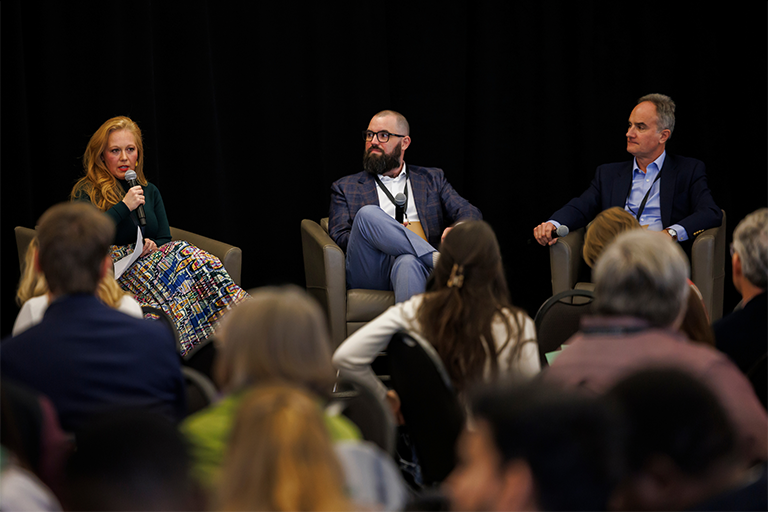Even in uncertain times, Hoosiers have reasons to feel good about Indiana’s progress toward a more sustainable and resilient future.
At the Indiana Sustainability and Resilience Conference (ISRC), held Feb. 28 at the Monroe Convention Center in Bloomington, Ind., US retreat from climate leadership was top of mind for the more than 450 attendees. In the weeks leading up the conference, the Trump administration made a series of declarations to slow climate action and pause committed funding for climate and clean energy projects, including projects benefiting Indiana communities and businesses.
During the conference’s plenary roundtable discussion, McKinney Family Foundation Executive Director Stephanie Goodrid Lawson acknowledged the difficult moment, but said she drew hope from the growth in Indiana’s environmental sector and progress on environmental issues over the last decade.
“There are so many organizations in the room that didn't exist nine years ago,” Goodrid Lawson said.
“And there is so much progress happening in the state of Indiana. From the $130 million we received for Solar for All to the $21 billion that has been granted to our state through [federal legislation] to the explosion of renewable energy development that is catapulting Indiana up the rankings for new solar and wind energy generation.”
Hosted by the Indiana University Environmental Resilience Institute and presenting supporter the Indianapolis Airport Authority, the event brought together students, academics, industry and government leaders, community groups, and others for a day of networking and knowledge sharing to advance Indiana’s sustainability and resilience.
[Photos: ISRC highlights Hoosier contributions to Indiana’s sustainability]
Joining Goodrid Lawson on stage were Solar United Neighbors (SUN) Indiana Program Director Zach Schalk and Indiana Energy Independence Fund (IEIF) Executive Director Alex Crowley to discuss in-state efforts to invest in climate solutions and increase civic engagement on sustainability issues.
At SUN, Schalk helps organize dozens of events to educate Hoosiers on the benefits of solar energy and advocate for policy that lowers barriers to access. In 2022, SUN successfully advocated for state legislation to make it easier for Indiana residents to petition homeowners associations to allow solar.
"We are helping to identify folks who can go and speak up and show that there are real people around the state who want solar in their backyard, who want the economic benefits, who want the clean air and healthy drinking water that comes with solar power," said Schalk.
More recently, SUN played an instrumental role in helping an Indiana coalition secure $130 million in federal funds to bring solar projects to income-qualified Hoosiers. Over the next five years, Solar Opportunities Indiana and the Industrial Heartland Solar Coalition are projected to nearly double the amount of residential solar in the state, benefiting more than 10,000 low-income households in communities such as Gary, Fort Wayne, Indianapolis, and Columbus.
“It’s a transformational opportunity for expanding access to solar and making concrete, material impacts for struggling households,” Schalk said.
“Participating households will save at least 20% on their monthly electric bills. That's huge savings for households that are struggling each month to keep the lights on.”
Financing clean energy and energy efficiency projects is a major hurdle for many low- and moderate-income Hoosiers and small business owners. The Indiana Energy Independence Fund, the state’s only green bank, is a new nonprofit focused on connecting Hoosiers, especially lower income households and undercapitalized organizations, to the capital they need to make projects affordable. Examples of projects that fit IEIF’s mission include home weatherization, nonprofit solar installations, electric vehicle charging infrastructure, and energy-efficient systems for small business owners.
"The lower the cost of financing, the faster the return, and the better, therefore, for the facility," Crowley said.
Between churches, nonprofits, businesses, and other groups, IEIF has identified more than $40 million of projects seeking financing. A more formal canvassing of the state planned over the next two years will likely uncover an even greater cache of qualified projects, Crowley said.
“We want to cover the whole state, with a special focus on rural parts of the state that are really hard to get to,” he said.
“In the next two years, I the Indiana Energy Independence Fund will be spending a lot of time increasing the funding that's available for Hoosiers to be able to expand this work.”
In the last two years, local, regional, and state efforts, including Indiana’s first state climate action plan, have identified more opportunities for climate action than ever before. Despite national headwinds, those plans should prove useful when future opportunities arise, Schalk said.
"Even if everything feels very uncertain today, we will be back in that position where there's more money than we know what to do with," he said. "We need to make sure that we are ready to capitalize on those opportunities.”
About the Environmental Resilience Institute
Indiana University’s Environmental Resilience Institute connects a broad coalition of government, business, nonprofit, and community leaders to help Indiana and the Midwest better prepare for the challenges of environmental change. Together, we integrate research, education, and community to create environmental resilience and climate solutions—building a more sustainable, equitable, and prosperous future. Learn more at eri.iu.edu.




